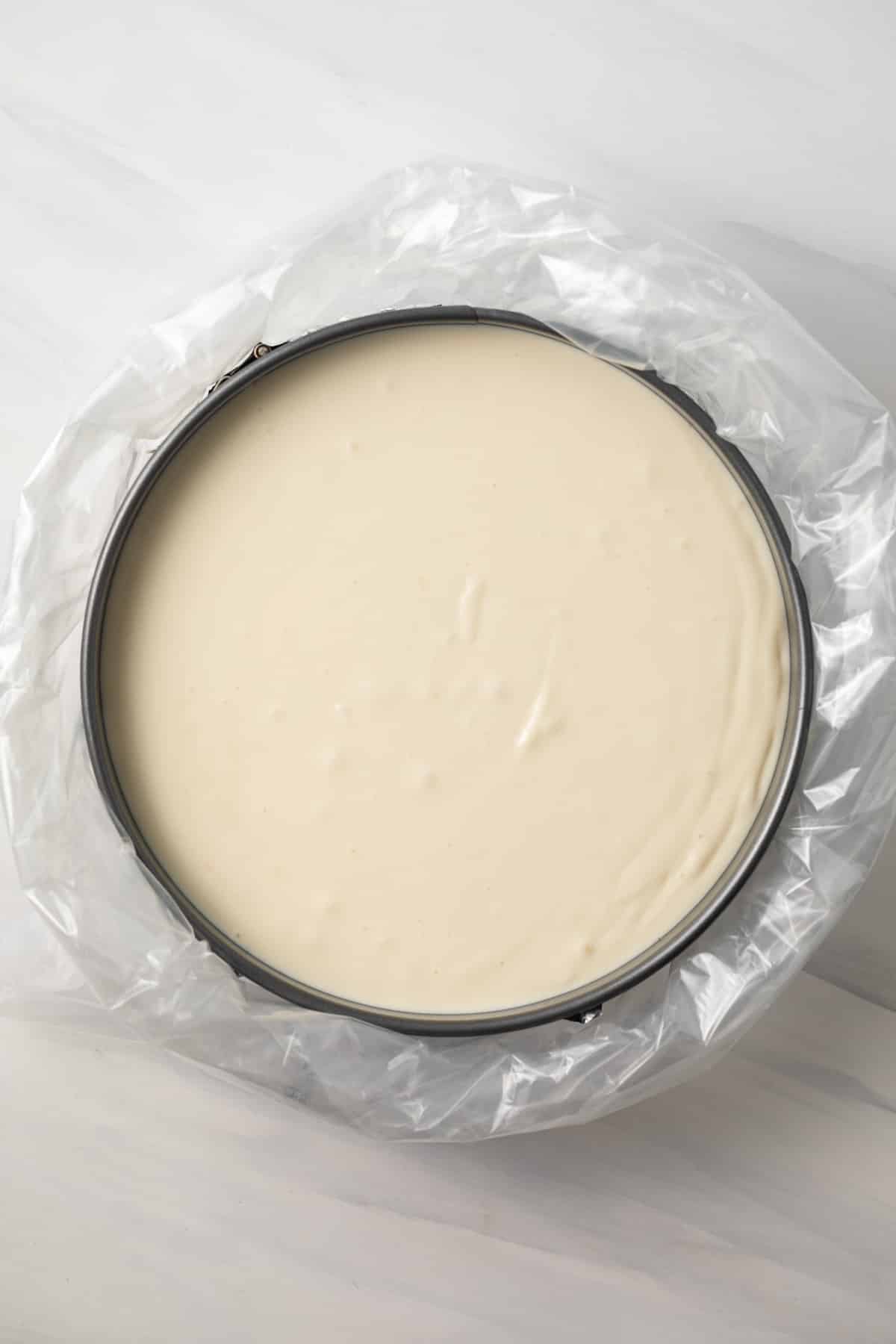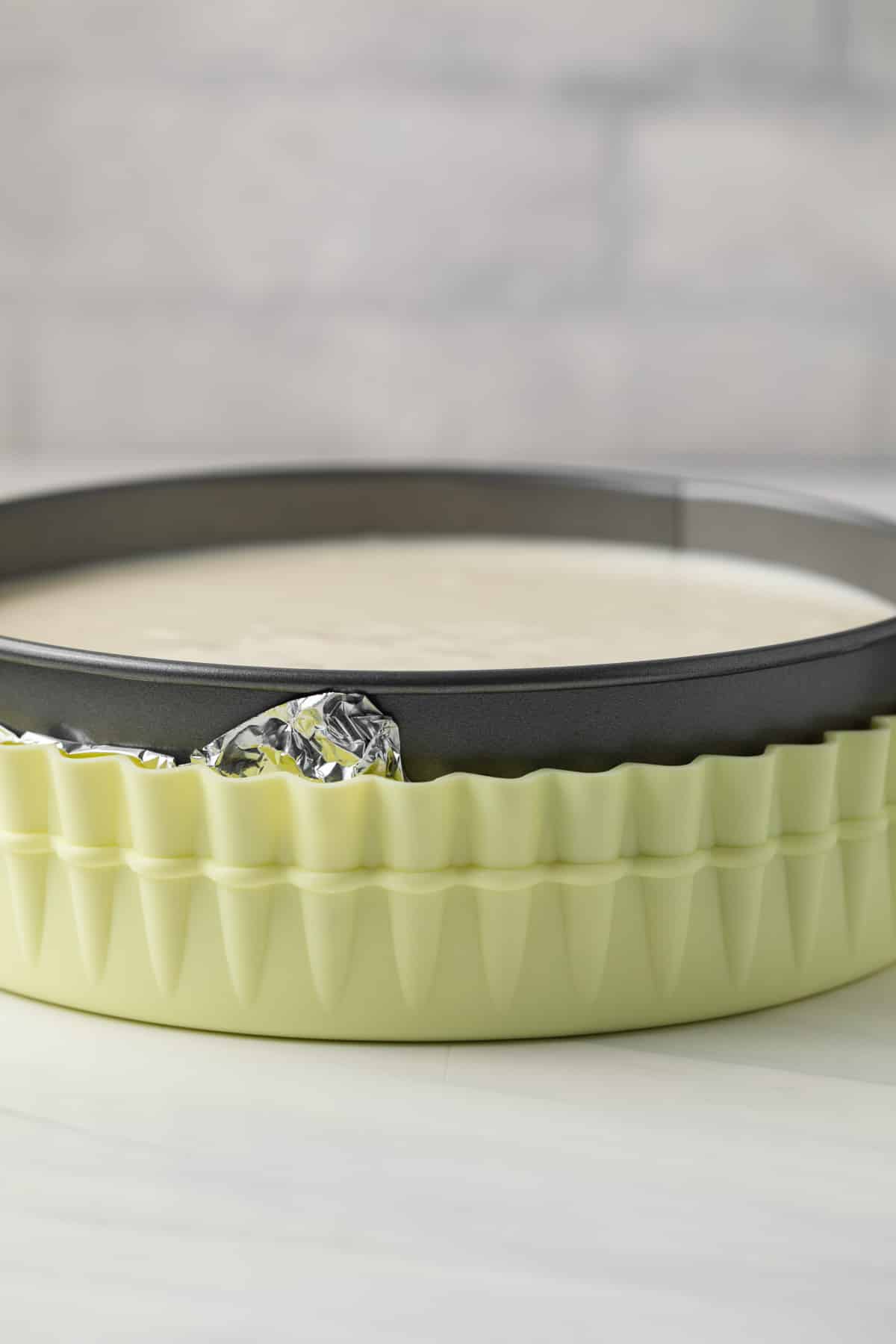How to Prevent Your Cheesecake Water Bath from Leaking
This post may contain affiliate links. Read the full disclosure here.
Cheesecakes are one of my favorite desserts. They are rich, creamy and so versatile. But they can be finicky and a little bit high maintenance. Cooking them in a water bath cooks them more consistently and keeps them from cracking. Here are a few tips for keeping the water bath from leaking into your cheesecake and causing a soggy crust.

I have a lot of cheesecake recipes on my website. I love cheesecakes. They’re creamy, decadent and delicious. And I’m not alone. There is a reason one of the most popular restaurant chains in the country, so maybe even the world, is called The Cheesecake Factory.
I love a good chocolate cake and pie too, but I have yet to dine at the Chocolate Cake Factory, or the Pie Factory!
Cheesecake, it seems, is a national treasure. And we must do what we can to protect it. There is nothing worse than a soggy cheesecake.
My perfect cheesecake recipe is my favorite – but I have found so many ways to modify it. My website has so many cheesecake varieties, whether you like fruity cheesecakes, candy cheesecakes, or nutty cheesecakes, you’ll find something that appeals.
You’ll notice that all of the baked cheesecake recipes on my site use a bain marie, or a water bath technique. This requires placing the cheesecake pan inside a larger roasting pan, and pouring hot water at least halfway up the sides of the pan.
It’s the key to an evenly baked and creamy cheesecake, with no cracks on the top! It really does work wonders. However, sometimes the water can leak into even the tightest spring form pan, and the crust can get mushy. It’s a lot of work to end up with soggy graham crackers, so this extra step of water-proofing the cake pans, if you will, is well worth it.
I have tested hundreds of cheesecake recipes. Trust me. Maybe even thousands. So I know the perils of water baths leaking, and I have had the opportunity to come up with a couple of different methods to prevent this from happening.
The first involves using an oven bag – you can buy these in just about any grocery store. But if you intend to make cheesecakes on repeat, like I do, you might want to invest in a silicone cheesecake sleeve. It’s essentially a sleeve that you drop the springform pan into that comes up higher on the sides than the water. Just don’t over fill the water!
How to Prevent Your Cheesecake Water Bath from Leaking
Using an oven bag:
The oven bag technique requires using a turkey-size plastic bag. These can be found in the plastic bag section of the grocery store.
First, wrap the springform pan in foil, and then place the foil-wrapped pan inside the plastic bag before you pour in the cheesecake batter. Fold the sides of the bag down so it covers the sides of the springform pan before placing it in the pan that will contain the water bath. When you pour the warm water into the pan, just be sure not to fill it up more than ⅔ of the way up the sides of the springform pan.




Using a cheesecake wrap:
For true cheesecake aficionados, it might be worth buying a silicone cheesecake sleeve. This works the same way as the plastic bag, essentially.
Wrap the springform pan in aluminum foil, and then drop that in the silicone sleeve. Then pour the batter into the pan, and place the whole thing, gently and carefully, into a baking dish. Pour the hot water into the larger pan, being sure to not pour it more than ⅔ of the way up the silicone sleeve.






What can I do to salvage (or at least try to) the crust if there was a leak?!
Unfortunately, there’s no salvaging the crust once water has penetrated it.
Thank you Jen for your advice on the silicone sleeve. I do make cheesecakes periodically and although I do the double wrap with the heavy foil, it never fails, I have some leaks – bummer. I ordered sleeves so I look forward to the next cheesecake to bake.
Why do you wrap the bottom of the springform pan with foil? Doesn’t that make it difficult to cut and serve the cheesecake without getting foil stuck in the bottom of the crust?
Wrapping the bottom with foil actually makes it easier to remove the cheesecake off the base. You slide a spatula between the bottom of the cheesecake and the foil and this allows you to lift the cheesecake right off the base and place it on a serving platter.
Do you not use the bottom part of the springform pan? It doesn’t look like there’s a bottom in the photo.
Always use the bottom with the sides of the pan. The bottom is lined with aluminum foil.
These are good ideas. However, my question is, may I use my silicone spring pan with glass bottom exactly as a metal pan? Will I be able to set it in the bath water etc and continue with the rest of the instructions?
I’ve never used a pan like you’re describing so I can’t offer advice on it.
Thank you for sharing the info on the silicone sleeve. It’s a easy great idea. I didn’t know it existed!
Is it really crucial to wrap it in foil and then put in the silicone?!? If the silicone prevent leaks at all, why would we need to wrap in foil as well? Just curious. Thank you
The foil goes on the inside of the pan and makes it easier to remove the cheesecake from the base. I always do this no matter if I use the silicone wrap or not.
I am confused. I have had the same leakage issue even when I carefully wrap my pan tight in wide heavy duty foil. Water should not be able to get in so I assumed it was from condensation. So how will the silicone sleeve over the foil help the issue? Not doubting but trying to understand the science.
With foil, there could be small tears or overlapping creases that allow water from the water bath to seep in. The silicone sleeve leaves no way for water to seep in.